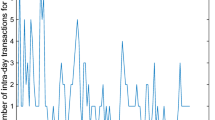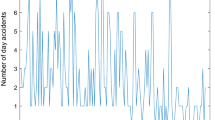Abstract
This paper introduces a non-stationary bivariate integer-valued auto-regressive process of order p (BINAR(p) with non-stationary moments. The BINAR(p) uses the conventional binomial thinning procedure and the cross correlation between the two related series is induced from the paired innovation terms. The conditional maximum likelihood (CML) approach is used to estimate the model parameters. Monte Carlo simulation experiments with bivariate Poisson innovations are implemented to assess the consistency and asymptotic properties of the proposed BINAR(p). In the application part, we consider two bivariate time series: The Ask and bid quotes from AT &T and the intra-day transactions of Mauritius Commercial Bank (MCB) and State Bank of Mauritius Holdings (SBMH). These series were fitted using the BINAR(p) with paired Poisson, Negative Binomial and Poisson-Lindley innovations and the results demonstrate that BINAR(p) with Negative Binomial yield better fitting and slightly lesser mean square error.













Similar content being viewed by others
References
Al Osh M, Alzaid A (1987) First-order integer-valued autoregressive process. J Time Ser Anal 8:261–275
Bulla J, Chesneau C, Kachour M (2017) A bivariate first-order signed integer-valued autoregressive process. Commun Stat-Theory Methods 46(13):6590–6604
Bulla J, Chesneau C, Kachour M (2017) A bivariate first-order signed integer-valued autoregressive process. Commun Stat-Theory Methods 46:6590–6604
Chen H, Zhu F, Liu X (2022) A new bivariate INAR (1) model with time-dependent innovation vectors. Stats 5(3):819–840
Chen H, Zhu F, Liu X (2023) Two-step conditional least squares estimation for the bivariate-valued INAR (1) model with bivariate skellam innovations. Commun Stat-Theory Methods 1–22
Du J, Li Y (1991) The integer-valued autoregressive (INAR(p)) model. J Time Ser Anal 12:129–142
Freeland R, McCabe B (2004) Analysis of low count time series data by Poisson autoregression. J Time Ser Anal 25(5):701–722
Freeland R, McCabe B (2004) Forecasting discrete valued low count time series. Int J Forecast 20:427–434
Fu T (2011) A review on time series datamining. Eng Appl Artif Intell 24:164–181
Jowaheer V, Mamode Khan N, Sunecher Y (2017b) A BINAR(1) time series model with cross-correlated COM-Poisson innovations. Commun Stat-Theory Methods
Karlis D, Ntzoufras I (2003) Analysis of sports data by using bivariate Poisson models. J R Stat Soc: Series D (The Statistician) 52(3):381–393
Khan NM, Oncel Cekim H, Ozel G (2020) The family of the bivariate integer-valued autoregressive process (BINAR (1)) with Poisson–Lindley (PL) innovations. J Stat Comput Simul 90(4):624–637
Kim H, Park Y (2008) A non-stationary integer-valued autoregressive model. Stat Pap 49:485–502
Kocherlakota S, Kocherlakota K (1992) Bivariate discrete distributions, vol 132. CRC Press, Boca Raon
Li Q, Chen H, Liu X (2021) A new bivariate random coefficient INAR (1) model with applications. Symmetry 14(1):39
Mamode Khan N, Sunecher Y, Jowaheer V (2016) Modelling a non-stationary BINAR(1) Poisson process. J Stat Comput Simul 86:3106–3126
Marshall A, Olkin I (1990) Multivariate distribution generated from mixtures of convolution and product families. Topics in Statistical Dependence, Block, Sampson y Sanits (Eds), Institute of Mathematical Statistics
McKenzie E (1986) Autoregressive moving-average processes with negative binomial and geometric marginal distrbutions. Adv Appl Probab 18:679–705
McKenzie E (1988) Some ARMA models for dependent sequences of Poisson counts. Adv Appl Probab 20:822–835
Minkova L, BalaKrishnan N (2014) Type-II bivariate Polya-Aeppli distribution. Stat Probab Lett 88:40–49
Nyholm K (2003) Inferring the private information content of trades: a regime-switching approach. J Appl Econom 18(4):457–470
Pedeli X, Karlis D (2011) A bivariate INAR(1) process with application. Stat Model: Int J 11:325–349
Pedeli X, Karlis D (2013) On estimation of the bivariate Poisson INAR process. Commun Stat-Theory Methods 35:514–533
Ristic M, Popovic B (2019) A new bivariate binomial time series model. Markov Process Related Fields 25:301–328
Schweer S, Weiss C (2014) Compound poisson INAR(1) processes: stochastic properties and testing for overdispersion. Comput Stat Data Anal 77:267–284
Silva N, Pereira I, Silva ME (2009) Forecasting in INAR (1) model. REVSTAT-Stat J 7(1):119–134
Steutel F, van Harn K (1979) Discrete analogues of self-decomposability and statibility. Ann Probab 7:3893–899
Steutel F, van Harn K (1986) Discrete operator self-decomposability and queing networks. Stoch Model 2:161–169
Su B, Zhu F (2021) Comparison of BINAR (1) models with bivariate negative binomial innovations and explanatory variables. J Stat Comput Simul 91(8):1616–1634
Sunecher Y, Mamodekhan N, Jowaheer V (2017) A GQL estimation approach for analysing non-stationary over-dispersed BINAR(1) time series. J Stat Comput Simul 87(10):1911–1924
Weiss C (2008) The combined INAR(p) models for time series of counts. Stat Probab Lett 78(13):1817–1822
Acknowledgements
This work is also part of my Post-Doctoral Fellowship on “The Family of Bivariate Integer-Valued Autoregressive Models” at the University of Bahia, Brazil. I am thankful to Prof. Paulo Jorge Canas Rodrigues and to the anonymous reviewers for their suggestions.
Funding
No funding was received for this research work.
Author information
Authors and Affiliations
Corresponding author
Ethics declarations
Conflict of interest
The authors declare no conflicts of interest.
Additional information
Publisher's Note
Springer Nature remains neutral with regard to jurisdictional claims in published maps and institutional affiliations.
Rights and permissions
Springer Nature or its licensor (e.g. a society or other partner) holds exclusive rights to this article under a publishing agreement with the author(s) or other rightsholder(s); author self-archiving of the accepted manuscript version of this article is solely governed by the terms of such publishing agreement and applicable law.
About this article
Cite this article
Sunecher, Y., Mamode Khan, N., Bakouch, H.S. et al. On Some Non-stationary Bivariate INAR(p) Models with Applications to Intra-day Stock Transaction Series. J Indian Soc Probab Stat (2024). https://doi.org/10.1007/s41096-024-00177-w
Accepted:
Published:
DOI: https://doi.org/10.1007/s41096-024-00177-w




